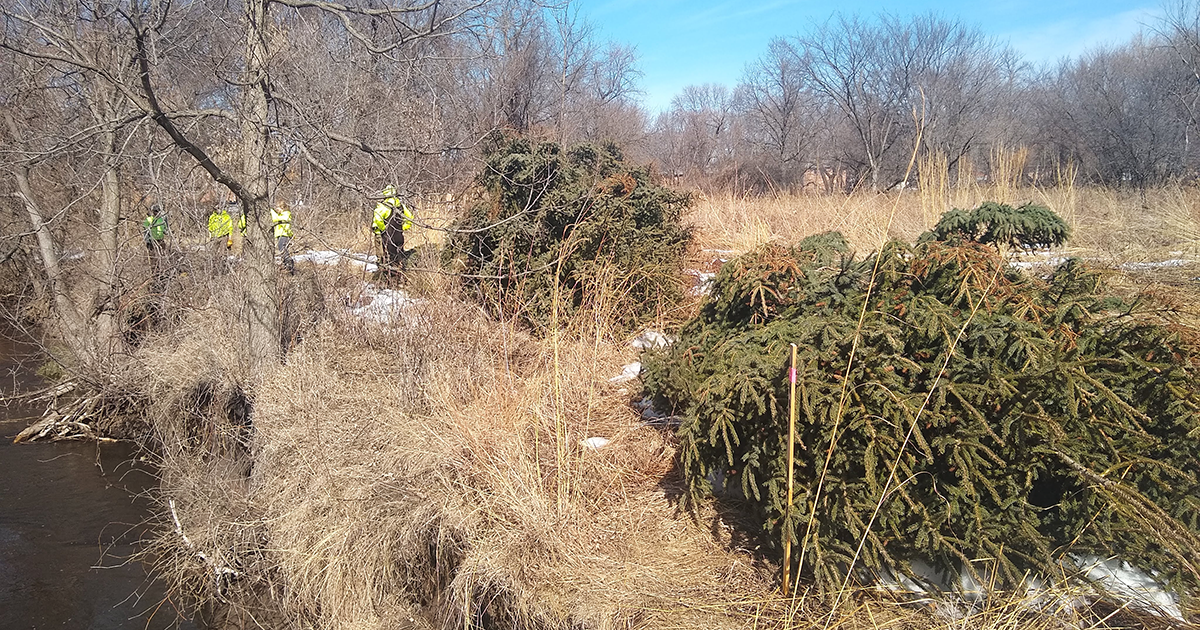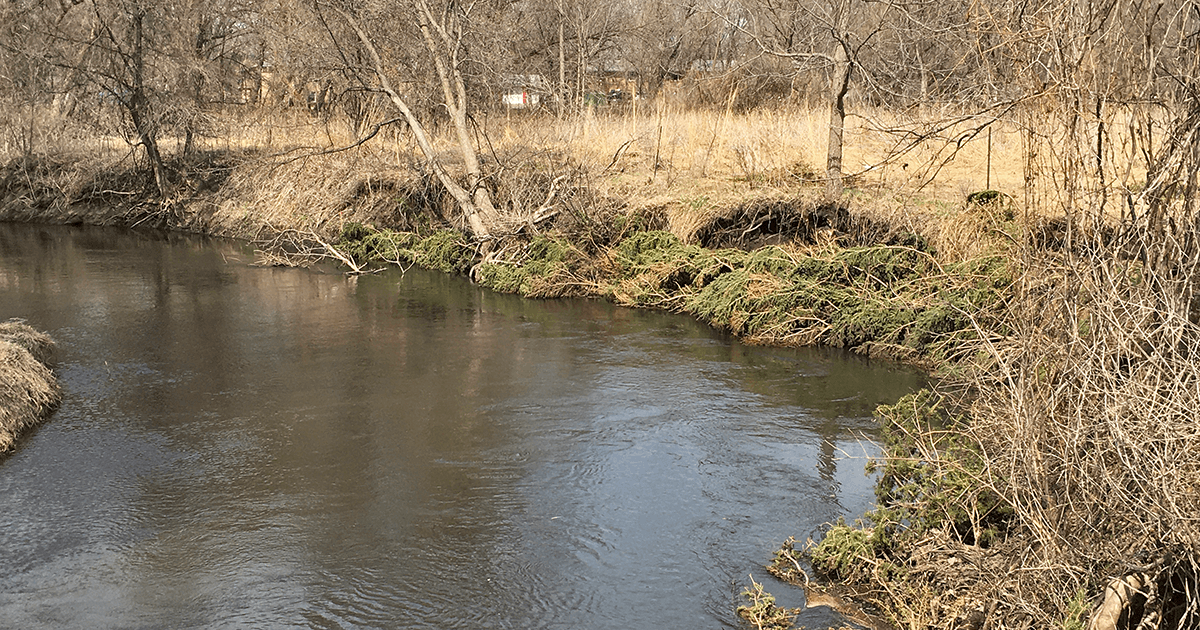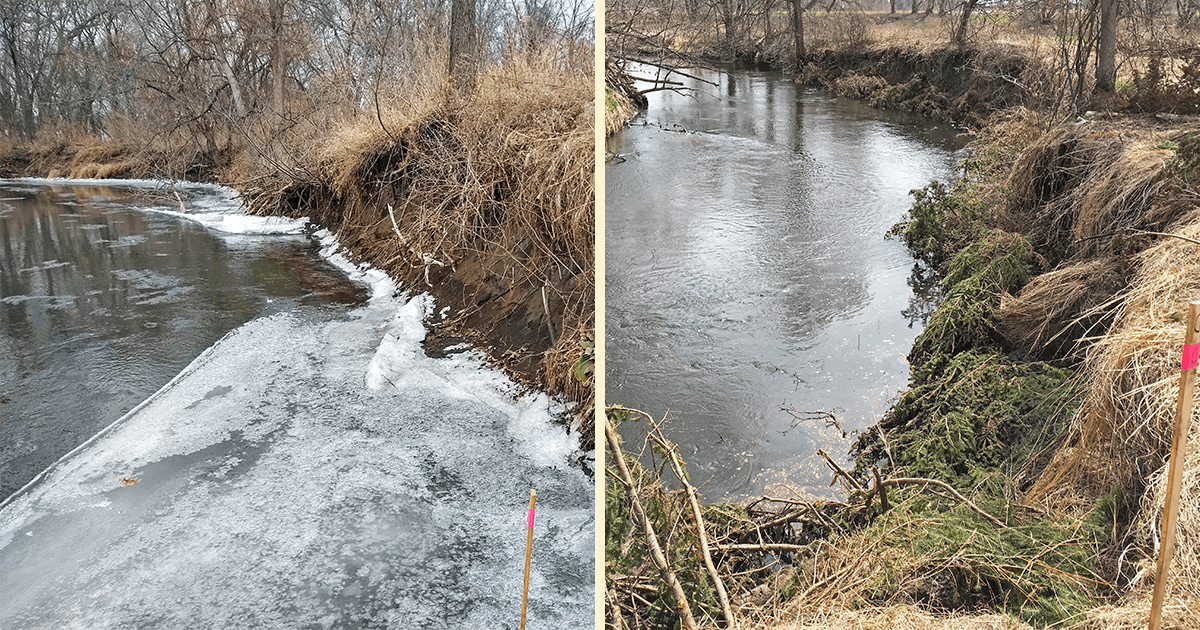Cedar and spruce shore up the Vermillion River's eroding banks
Before, left: The streambank at Vermillion River Linear Park in Hastings has eroded multiple feet each year. After, right: Spruce and cedar brush now lines the bank to naturally rebuild the riverbank.
Many of the stories you read about FMR's Land Conservation program are about beautiful blooms and native species returning to our restoration sites, but what happens to all the plants we remove in preparation for these restorations?
This spring at Vermillion River Linear Park in Hastings, we put some of that vegetation to good use in a streambank stabilization project.
Erosion at Vermillion River Linear Park
In 2014, FMR ecologists completed a management plan for Vermillion River Linear Park, a 60-acre natural area in Hastings along the Vermillion River itself, a major tributary of the Mississippi. Much of the plan centered around removing invasive woody plants in the riverside woodlands and restoring native prairie on the site's degraded grasslands.
The plan also noted places along the Vermillion River where erosion was becoming an issue. That's a problem not only for the land itself — we were losing multiple feet of the bank at the site each year — but also for water. Too much sediment in a river can spell trouble for water quality, and for aquatic plants and animals. (Check out our online lesson about erosion.)
Since 2015, FMR has been working in phases to restore almost 50 acres at the site as we acquired state funds to support the project. In our current phase — supported by funding from the Outdoor Heritage Fund — we're restoring 27 acres of prairie habitat. That includes removing invasive plants like smooth brome and spotted knapweed, and replacing them with diverse prairie grasses and wildflowers that will improve habitat and reduce erosion by holding the land in place with their deep roots.
But we're also directly addressing the immediate riverbank erosion with a method of streambank stabilization that makes use of natural materials from the same site.
Recycling removed plants for streambank stabilization
We've removed tons of woody vegetation that had crept into the former grassland areas over the past few decades — mostly buckthorn, Tatarian honeysuckle, and Siberian elm. But we also had to remove native red cedar, since this plant can come to dominate prairies without the frequent fires that once maintained these habitats.
Wood from spruce and cedar is strong and resistant to rot, making it an ideal natural material to shore up a riverbank. We wanted to try to create a revetment, or a constructed barricade, out of these trees, rather than other methods that use less natural rip-rap to armor the slope. Other methods would re-grade and reshape the bank, which, while effective, would be cost-prohibitive and would further eat into the restored acres at the site.
With approval from the City of Hastings and the U.S. Army Corps of Engineers, FMR worked with staff from the Dakota County Soil and Water Conservation District (SWCD) and the Vermillion River Watershed Joint Powers Organization to plan the revetment. SWCD staff developed the engineering design plans to push the project forward.
In early March 2021, our subcontractors anchored 6-8-foot lengths of red cedar and spruce into the streambank. Now this brush covers 200 linear feet of the bank, with multiple tiers in areas where the eroded bank was especially high. Here's a peek into the process:

Crews from our subcontractor — Applied Ecological Services (now Resource Environmental Solutions) — staged entire spruce and red cedar trees near the river, then cut the branches off one side of each tree so the trunks could lay flat against the riverbank.

A crew member installs the brush so the cedar and spruce branches stick out into the river to deflect and slow the current and to collect sediment, rebuilding the bank and already providing habitat.

Due to rising and falling water levels, it took over a month to find a week's worth of days when the crew could carefully place and secure brush along 200 feet of the riverbank.
Benefits of a cedar and spruce revetment
Cedar and spruce brush helps absorb energy from the current to both deflect and slow it down, not only protecting the bank from the erosive forces of the water but also allowing sediment to fall out of the current and rebuild the bank.
The hope is that these areas will eventually gain enough sediment that seed from the nearby prairie restoration can naturally spread there, grow, and restore the riverbank.
The collecting sediment can also provide organic food for many stream-dwelling insects, in turn creating feeding locations for fish and species up the food chain.
The project's other benefits include narrowing the river channel, which can help eliminate the sandy flat bottoms common to the wide, eroded streams of the area. Trout need rocky or gravel substrate, so removing sand and sediment may improve habitat for trout and other fish. The faster water will also be cooler, which is essential for many aquatic organisms, including trout.
Lastly, the project will help protect FMR’s initial investment in our upland habitat restoration. This particular spot in the river was losing multiple feet of bank per year. Aside from the obvious water quality benefit of keeping all of that extra sediment out of the Vermillion and Mississippi rivers, the project has the advantage of making sure the restored upland prairie habitat doesn’t slowly erode away.
What's next
So far, we're happy with the revetment project results, and it's performing as it should — deflecting current and slowing flow along the bank. It's still early in the spring rainy season, but we're confident that the project will hold up and will benefit water quality and habitat in the Vermillion River and at Vermillion River Linear Park.
We also have more riverbank stabilization and erosion control projects on the way this year. FMR is partnering with the City of Elk River and the Sherburne County Soil and Water Conservation District to tackle two larger projects along the Elk River at the William H. Houlton Conservation Area and Bailey Point Nature Preserve.
Volunteer with us
While we sometimes work with contractors, we also rely on volunteers to support our habitat projects. If you'd like to get your hands dirty restoring these places, check out our upcoming stewardship events.
